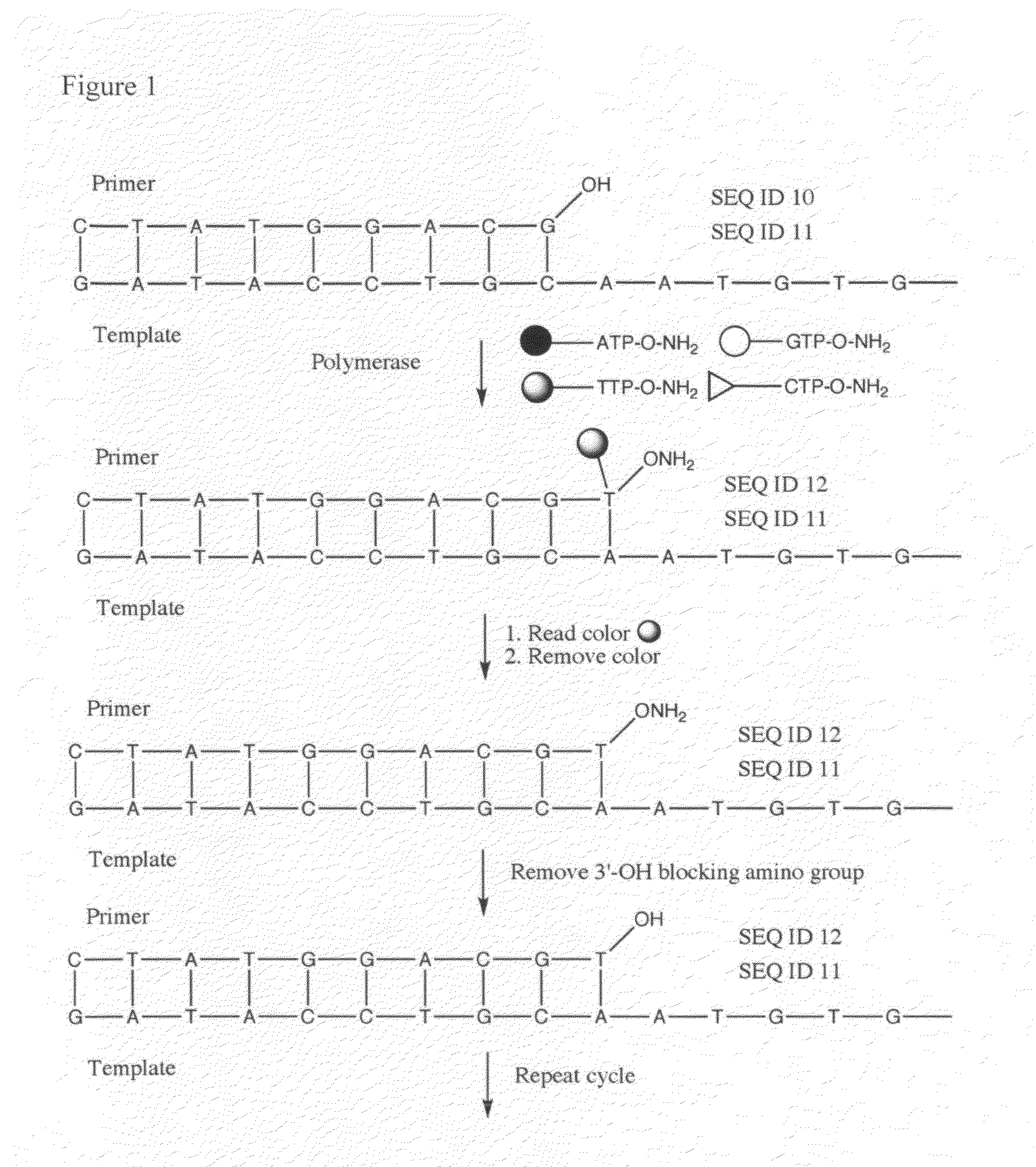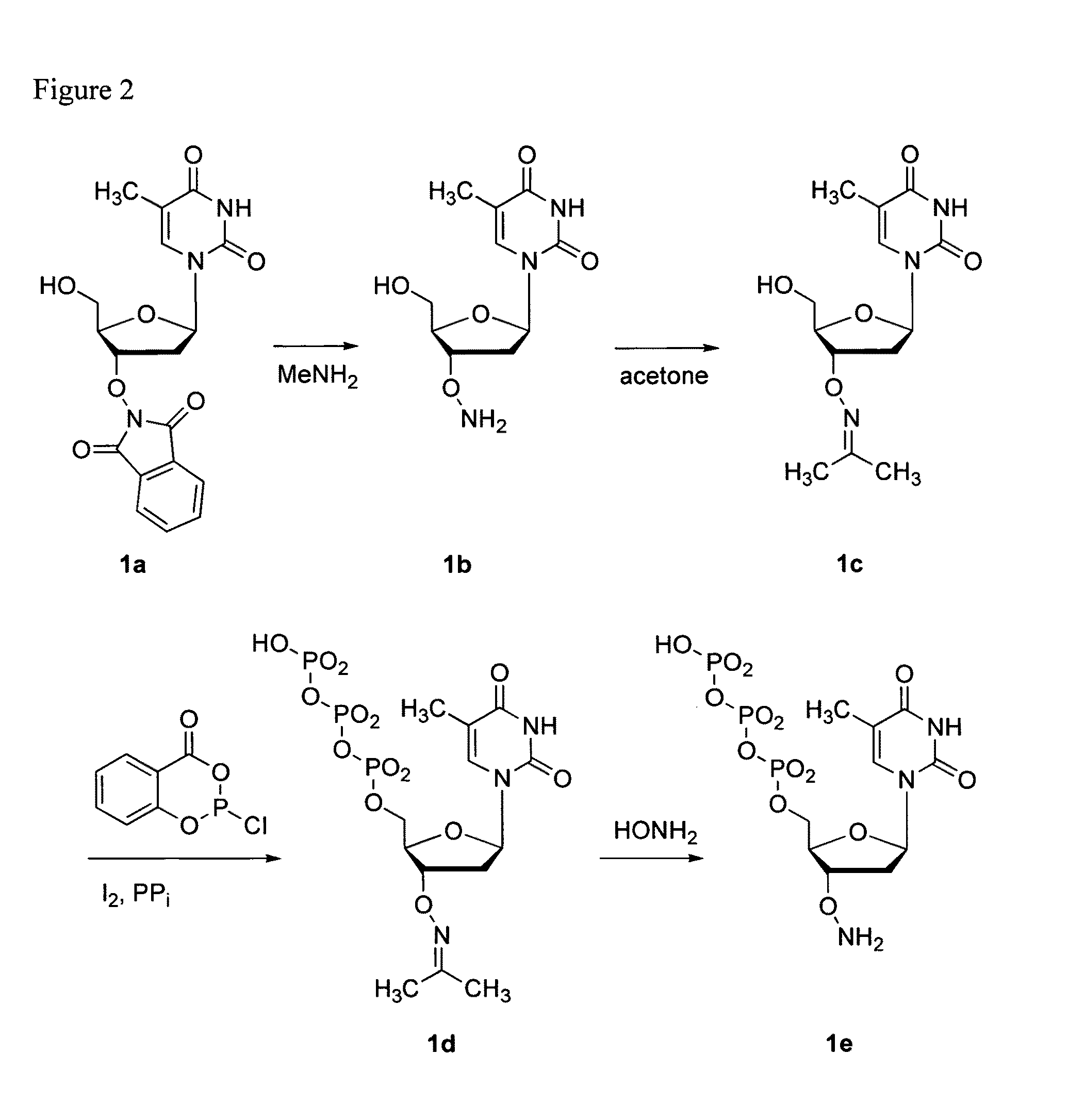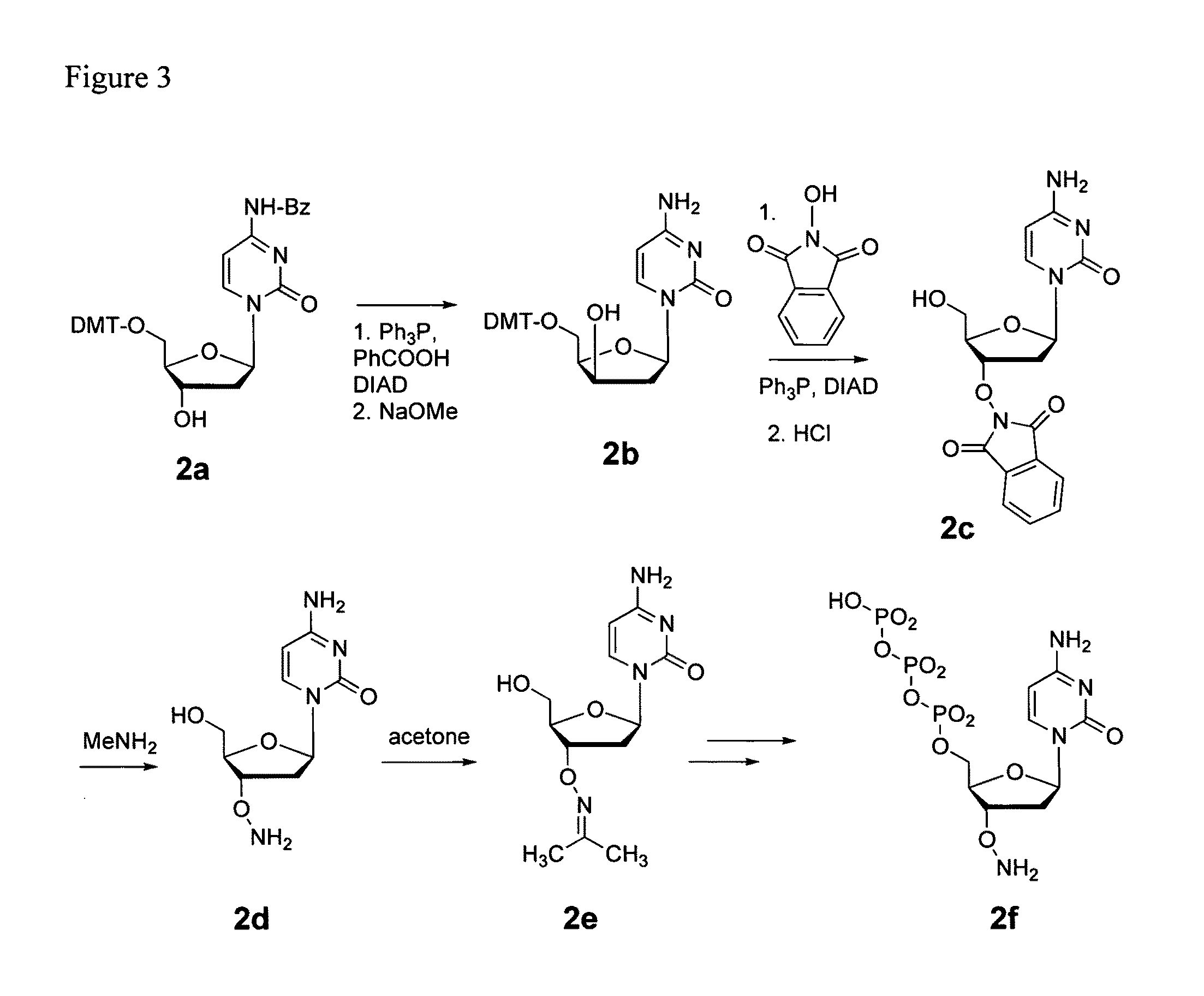Reagents for reversibly terminating primer extension
a technology of primer extension and reversible termination, which is applied in the field of nucleic acid chemistry, can solve the problems of loss of strands, no chemical reaction can convert a 2′,3′-dideoxyterminated oligonucleotide into, and no chemical reaction can substantially damage the oligonucleotid
- Summary
- Abstract
- Description
- Claims
- Application Information
AI Technical Summary
Problems solved by technology
Method used
Image
Examples
example 1
Synthesis of TTP-ONH2 (FIG. 2)
3′-O—(N-Acetone-oxime)-thymidine (1c)
[0049]3′-O-Phthalimido-thymidine (1a), prepared following procedures described in literature [De Clercq, E., Inoue, I., Kondo, K. (1990) Preparation of 3-O-amino-2′-deoxyribonucleoside derivatives as antiviral agents for human retrovirus, particularly human immunodeficiency virus. Eur. Pat. Appl. 14 pp][Kondo, K., Ogiku, T., Inoue, I. (1985) Synthesis of 5′(3′)-O-amino nucleosides. Symp. Nucleic Acids Chem. 16, 93-96][Burgess, K., Gibbs, R. A., Metzker, M. L., Raghavachari, R. (1994) Synthesis of an oxyamide linked nucleotide dimer and incorporation into antisense oligonucleotide sequences. J. Chem. Soc. Chem. Commun. 8, 915-916] [Cook, P. D., Sanghvi, Y. S. (1994) Preparation of antisense heteroatomic oligonucleotide analogs. PCT Int. Appl. 90 pp]. The procedures from these literature citations are specifically incorporated into this specification by citation. This material (1.15 g, 3.0 mmol) was dissolved in aqueou...
example 2
Synthesis of dCTP-ONH2 (FIG. 3)
5′-O-Dimethoxytrityl-xylo-2′-deoxycytidine (2b)
[0055]To a solution of N4-benzoyl-5′-O-dimethoxytrityl-2′-deoxycytidine (2a, 8.9 g, 14 mmol), benzoic acid (2.5 g, 20 mmol) and triphenylphosphine (5.2 g, 20 mmol) in THF (150 mL) was added DIAD (3.7 mL, 20 mmol) at 0° C. The reaction was allowed to warm to RT overnight and then was quenched by the addition of water (0.5 mL). The solvents were removed in vacuo. Purification by FLC (silica, gradient 50 to 100% EtOAc in hexanes) gave N4-benzoyl-3′-O-benzoyl-5′-O-dimethoxytrityl-xylo-2′-deoxycytidine (13.7 g) as a colorless foam which, according to NMR, contained significant amounts of triphenylphosphine oxide, as well as some elimination product (2′,3′-olefin). This intermediate was re-dissolved in MeOH (450 mL) and treated with a solution of sodium methoxide in MeOH (5.3 M, 4 mL, 21 mmol). After 2 h at RT, the reaction was quenched by the addition of AcOH (glacial, 1.25 mL). The solvents were removed in vac...
example 3
Synthesis of dATP-ONH2 (FIG. 4)
5′-O-Dimethoxytrityl-xylo-2′-deoxyadenosine (3b)
[0064]To a solution of 5′-O-dimethoxytrityl-2′-deoxyadenosine (3a, 8.3 g, 15 mmol), benzoic acid (3.0 g, 24 mmol) and triphenylphosphine (6.5 g, 24 mmol) in THF (250 mL) was added DIAD (4.5 mL, 24 mmol) at RT. After 1 h the reaction was quenched by the addition of MeOH (5 mL). The solvents were removed in vacuo. Purification by FLC (silica, gradient 3 to 5% MeOH in CH2Cl2) gave 3′-O-benzoyl-5′-O-dimethoxytrityl-xylo-2′-deoxyadenosine (12 g) as a colorless foam which, according to NMR, contained some triphenylphosphine oxide as well as some elimination product (2′,3′-olefin). This intermediate was redissolved in MeOH (300 mL) and treated with a solution of sodium methoxide in MeOH (5.3 M, 4 mL, 21 mmol). After 16 h at RT, the reaction was quenched by the addition of AcOH (glacial, 1.5 mL). The solvents were removed in vacuo. Purification by FLC (silica, gradient 3 to 10% MeOH in CH2Cl2) gave 5′-O-dimethoxy...
PUM
 Login to View More
Login to View More Abstract
Description
Claims
Application Information
 Login to View More
Login to View More - R&D
- Intellectual Property
- Life Sciences
- Materials
- Tech Scout
- Unparalleled Data Quality
- Higher Quality Content
- 60% Fewer Hallucinations
Browse by: Latest US Patents, China's latest patents, Technical Efficacy Thesaurus, Application Domain, Technology Topic, Popular Technical Reports.
© 2025 PatSnap. All rights reserved.Legal|Privacy policy|Modern Slavery Act Transparency Statement|Sitemap|About US| Contact US: help@patsnap.com



